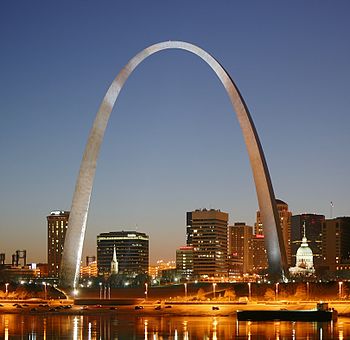Weighted catenary

A weighted catenary is a catenary curve, but of a special form. A "regular" catenary has the equation
for a given value of a. A weighted catenary has the equation
and now two constants enter: a and b.
Significance
A catenary arch has a uniform thickness. However, if
- the arch is not of uniform thickness,[1]
- the arch supports more than its own weight,[2]
- or if gravity varies,[3]
it becomes more complex. A weighted catenary is needed.
The aspect ratio of a weighted catenary (or other curve) describes a rectangular frame containing the selected fragment of the curve theoretically continuing to the infinity. [4][5]

Examples
The Gateway Arch in the American city of St. Louis (Missouri) is the most famous example of a weighted catenary.
Simple suspension bridges use weighted catenaries.[5]
References
- ^ Robert Osserman (February 2010). "Mathematics of the Gateway Arch" (PDF). Notices of the AMS.
- ^ Re-review: Catenary and Parabola: Re-review: Catenary and Parabola, accessdate: April 13, 2017
- ^ MathOverflow: classical mechanics - Catenary curve under non-uniform gravitational field - MathOverflow, accessdate: April 13, 2017
- ^ Definition from WhatIs.com: What is aspect ratio? - Definition from WhatIs.com, accessdate: April 13, 2017
- ^ a b Robert Osserman (2010). "How the Gateway Arch Got its Shape" (PDF). Nexus Network Journal. Retrieved 13 April 2017.

